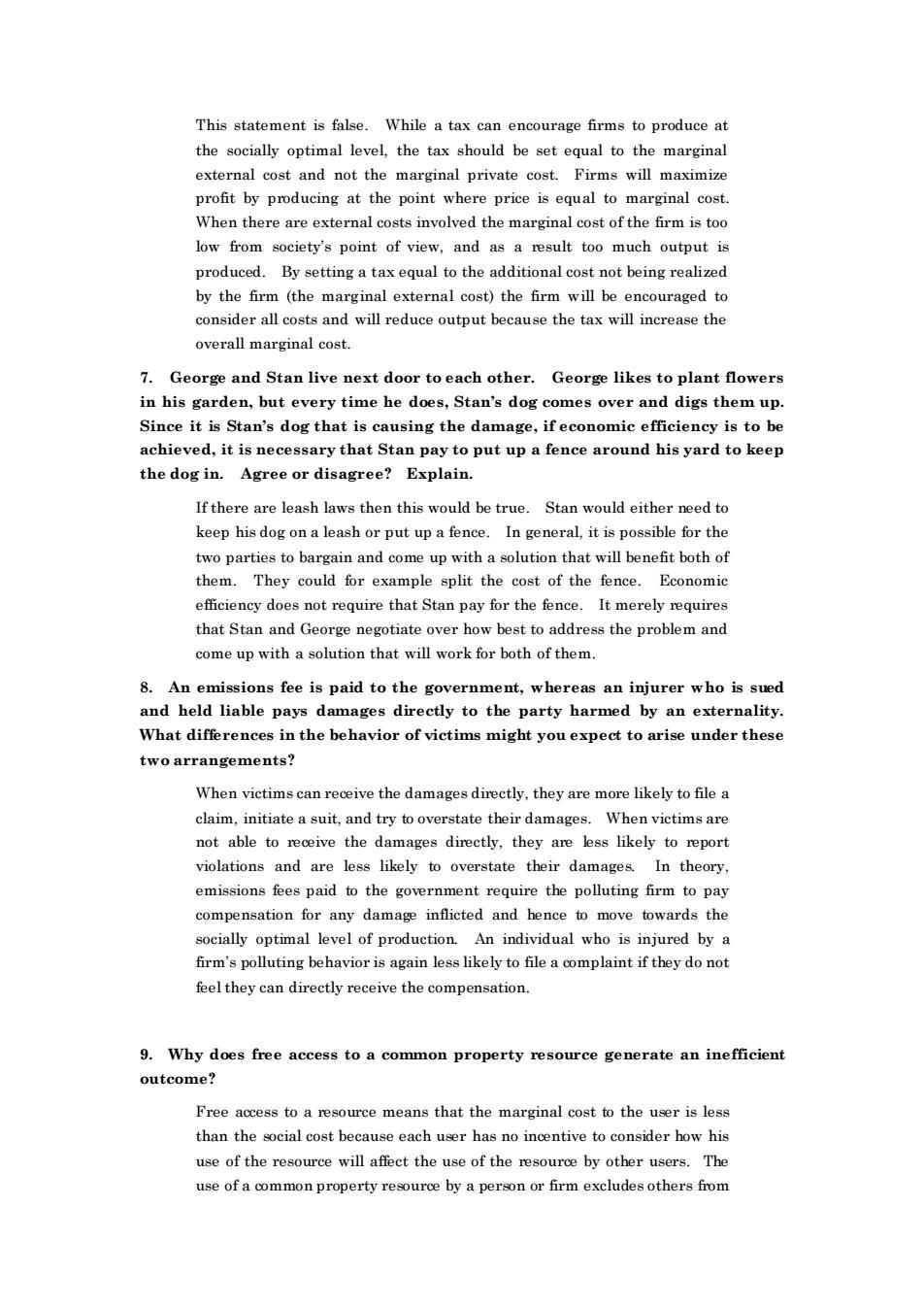正在加载图片...

This statement is false.While a tax can encourage firms to produce at the socially optimal level,the tax should be set equal to the marginal external cost and not the marginal private cost.Firms will maximiz profit by producing at the point where price is equal to marginal cost When there are external costs involved the marginal cost of the firm is too low from society's point of view,and as a result too much output is produced.By settina taxequal to the additional cos not being realized by the firm (the marginal external cost)the firm will be encouraged to consider all costs and will reduce output because the tax will increase the overall marginal cost 7.George and stan live next door to each other.George likes to plant flowers in his garden.but every time he does.Stan's dog comes over and digs them up. Since it is Stan's dog that is ved,it ausing necessary that S a pay to put up a fence aro d to ke the dog in. Agree or disagree?Explain. If there are leash laws then this would be true.Stan would either need t keep his dog on a leash or put up a fence.In general.it is possible for the two parties to bargain and come up with a solution that will benefit both of them.They could for ex mple split the cost of the fence.Economic ency doe ot require that Stan pay for the e t requir that Stan and George negotiate over how best to address the problem and come up with a solution that will work for both of them 8.An emissions fee is paid to the government.whereas an iniurer who is sued and held liable pays damages directly to the party harmed by an externality. What differences in the behavior of victims might you expect to arise under these two arrangements? When victims can recive the damages directly,they are more likely to file claim,initiate a suit,and try to overstate their damages. When victims are not able to receive the damages directly,they are less likely to report violations and are less likely to overstate their damages.In theory, emissions fees paid to the government require the polluting firm to pav compensation for any damage inflicted and hence towards the socally optimal eve of production An individual who is inju by a firm's polluting behavior is again less likely to file a complaint if they do not feel they can directly receive the compensation. 9.Why does free access to a common property resource generate an inefficient outcome? Free access to a resource means that the marginal cost to the user is less than because has no his use of the resource will affect the use of the resource by other users.The use of a common property resource by a person or firm excludes others fromThis statement is false. While a tax can encourage firms to produce at the socially optimal level, the tax should be set equal to the marginal external cost and not the marginal private cost. Firms will maximize profit by producing at the point where price is equal to marginal cost. When there are external costs involved the marginal cost of the firm is too low from society’s point of view, and as a result too much output is produced. By setting a tax equal to the additional cost not being realized by the firm (the marginal external cost) the firm will be encouraged to consider all costs and will reduce output because the tax will increase the overall marginal cost. 7. George and Stan live next door to each other. George likes to plant flowers in his garden, but every time he does, Stan’s dog comes over and digs them up. Since it is Stan’s dog that is causing the damage, if economic efficiency is to be achieved, it is necessary that Stan pay to put up a fence around his yard to keep the dog in. Agree or disagree? Explain. If there are leash laws then this would be true. Stan would either need to keep his dog on a leash or put up a fence. In general, it is possible for the two parties to bargain and come up with a solution that will benefit both of them. They could for example split the cost of the fence. Economic efficiency does not require that Stan pay for the fence. It merely requires that Stan and George negotiate over how best to address the problem and come up with a solution that will work for both of them. 8. An emissions fee is paid to the government, whereas an injurer who is sued and held liable pays damages directly to the party harmed by an externality. What differences in the behavior of victims might you expect to arise under these two arrangements? When victims can receive the damages directly, they are more likely to file a claim, initiate a suit, and try to overstate their damages. When victims are not able to receive the damages directly, they are less likely to report violations and are less likely to overstate their damages. In theory, emissions fees paid to the government require the polluting firm to pay compensation for any damage inflicted and hence to move towards the socially optimal level of production. An individual who is injured by a firm’s polluting behavior is again less likely to file a complaint if they do not feel they can directly receive the compensation. 9. Why does free access to a common property resource generate an inefficient outcome? Free access to a resource means that the marginal cost to the user is less than the social cost because each user has no incentive to consider how his use of the resource will affect the use of the resource by other users. The use of a common property resource by a person or firm excludes others from